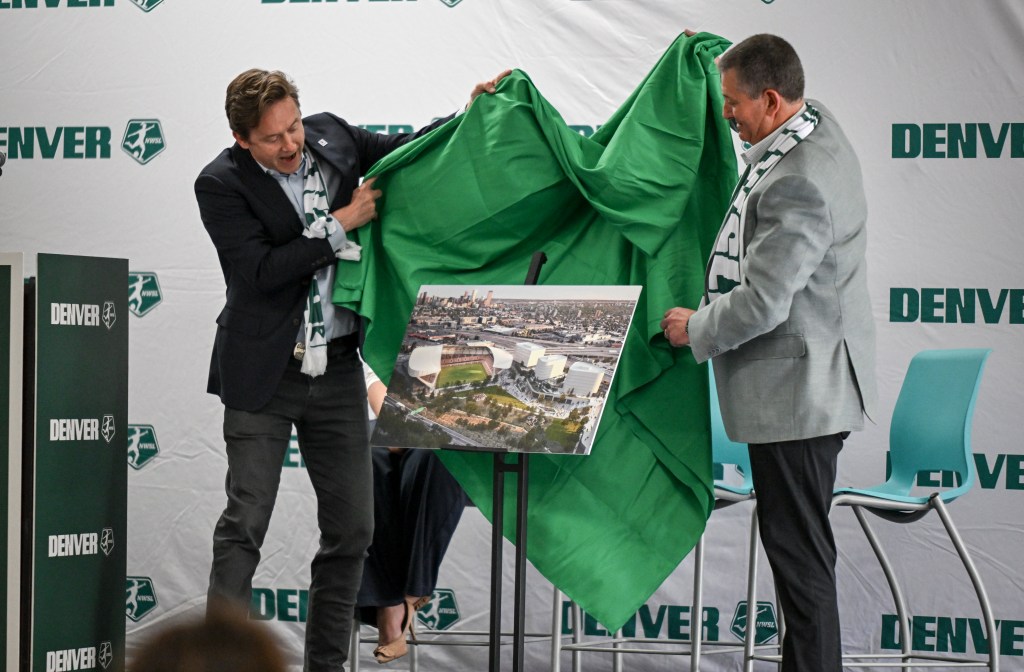On May 12th, Denver’s city council overwhelmingly approved $70 million towards the nascent National Women’s Soccer League team’s new soccer stadium and surrounding entertainment complex. Inspiring news. I wanted a first-hand look at the site.
But where? For even the most enthusiastic supporters do not name the neighborhood where the complex will reside. Official statements tout the location as “Santa Fe Yards” – a name that is yet to appear on a map of Denver.
Makes sense, because the actual neighborhood does not yet exist. Currently vacant dirt just south of Interstate 25 between Broadway and Santa Fe, there is not much to see. Instead, assurances: the $70 million investment, primarily to purchase the land, will provide a boost of economic activity, including “restaurants, bars, and shops.” Writing for the Colorado Sun, columnist Mario Nicolais gushed: “It is like a whole neighborhood winning the lottery.”
I thought of this image – a new neighborhood rising from dirt by winning the economic lottery of government support – while walking home up Colfax Avenue just north of the Capitol. Once Denver’s beating heart, Colfax runs astride several existing neighborhoods, each with their own restaurants, bars, and shops, a rich history memorialized by great works like Kerouac’s On The Road and the eponymous album by the Delines.
Small echoes of the proposed site accompanied my walk. A vacant building on the left past Logan Street; several abandoned stores; an empty lot after Ogden. Across Franklin, a long row of dilapidated houses slowly falling into themselves; beyond Williams Street boarded-up buildings lean gently on each other. There is an existing entertainment complex on Colfax these days, but it has a very different feel, and is unlikely to be transformed by the forthcoming elevated bus stops.
Opponents of the new entertainment complex were chided by Nicolais as “short-sighted,” in part for citing “other unrelated priorities.” But the vacant lots on Colfax and across Denver whispered an all-to-familiar word: housing. Last month Denver ranked 12th in the nation for the gap between home prices and household income.
So here is a modest proposal for the City Council: provide Denver’s existing neighborhoods the same winning lottery ticket afforded the proposed entertainment complex. Offer similar terms – subsidize new construction by purchasing the land — for anyone who builds on these vacant and abandoned lots.
Or broader: give the same deal to the public fans buying tickets for stadium seats as the private group who will own them. For new homebuyers, Denver could purchase the land under their houses, subsidizing the price of homes by about 15% to 25%.
Like the complex’s supporters, I harbor a deep passion for soccer and women’s athletics. I played, coached teams for my sons and daughter, and now spend many weekends as a referee, willingly accosted by fans loudly questioning my mental capacity. I have been a spectator at games for DU men’s and women’s teams, local clubs, high schools, a semi-pro team, and a spontaneous neighborhood match which ended with cupcakes. I truly, deeply love the sport. But there are many avenues for soccer enthusiasts that do not entail $70 million of municipal spending.
Soccer will be Denver’s only professional sport with two local stadiums. The new NWSL stadium (capacity 14,500) will be just eleven miles away from the existing MLS stadium (capacity 18,000). We can all agree that loyal fans deserve a dedicated soccer stadium. But is it short-sighted to question spending $70 million to build a second?
The new stadium will host NWSL games just 13 days per year, but it is crucial. “Without the stadium, the team likely wouldn’t have stayed in Denver,” the head of the ownership group confided, while also envisioning the entertainment complex as “a destination place that’s 365 days a year, 24 hours a day, seven days a week.”
This is a shell game — follow the ball as the three cups rotate. No stadium, then no team. But without the entertainment complex, no stadium. And minus millions in public dollars, no complex. Because the intense passion of fans for soccer and women’s athletics is worth far, far less to investors if it comes without government subsidy. The stadium is soccer bait, dangled in front of an eager audience, and once snatched by the City Council the full cage of the entertainment complex will fall down around it, trapping $70 million of public support.
In an artist rendition of the proposed site, if you gaze across the four broad lanes of Interstate 25 and past the commercial buildings, one can just make out residential city blocks in the distance. If we all want something to cheer, City Council members should give the same incentives and attention to building in our existing neighborhoods as they have for the vacant dirt of the new entertainment complex.
Alexander Ooms lives in central Denver and supports Tottenham Hotspur, who are usually not very good.
Sign up for Sound Off to get a weekly roundup of our columns, editorials and more.
To send a letter to the editor about this article, submit online or check out our guidelines for how to submit by email or mail.


